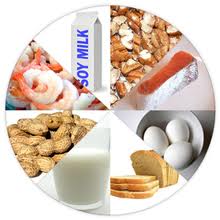The difference between an allergy and intolerance:
Food Allergy
- Occurs when the immune system reacts to a certain food

- The body creates immunoglobin E (IgE)
- When these antibodies react with food the body releases massive amounts of chemicals and histamines to protect the body – causing a number of symptoms of an allergic reaction
Food Intolerance
- Is an adverse food-induced reaction that does not involve the immune system
- E.g. Lactose Intolerance – in which the person lacks an enzyme that is needed to digest the milk sugar (lactose) – symptoms include gas, bloating, abdominal pain, and diarrhea
Common Symptoms of an Allergic Reaction
- Tingling sensation in the mouth
- Swelling of the tongue and throat
- Difficulty swallowing
- Wheezing and coughing and difficulty breathing
- Hives / rashes
- Vomiting
- Headache
- Abdominal cramps
- Diarrhea
- Drop in blood pressure – feeling faint
- Raised blood pressure
- Loss of consciousness
- Death
Allergic reaction symptoms…
- usually appear within minutes or up to 2 hours after consuming
- not all symptoms need to be present
- don’t appear in any particular order
- no two reactions are the same
Diagnosis
- Two forms of diagnosis if suspected of allergies:
Skin Testing
- Suspected allergens are injected into skin and reactions are evaluated and diagnosed.
Blood Testing
- measures a “total IgE level” and is determined through the use of radiometric.
- Uses anti-IgE antibodies with radioactive isotopes for quantifying the levels of IgE antibody in the blood.
Treatment
- strict avoidance to allergy causing food is key
- read ingredient labels for all foods – if the product doesn’t have a label than the allergic person shouldn’t eat it
- Antihistamines- [Loratadine (Claritin)] block receptor sites for IgE antibody.
- Cortisone- Reduce swelling from rashes, hives, swelling etc.
- Vaccination- Gradual increases of allergen is introduced into blood stream to reduce hypersensitivity.
- Epinephrine- (Epipen) suppresses the immune system and release of IgE antibodies.
Is there a cure for food allergies?
- Currently there are no medications that cure allergies
- Strict avoidance is the only way to avoid a reaction
Top 8 Allergy-Causing Foods
- Peanuts
- Nuts
- Fish
- Shellfish
- Eggs
- Soy
- Dairy products
- Wheat
What is ANAPHYLAXIS?
It is the most severe and life threatening type of allergic reaction. It can happen within minutes after eating or smelling a food. Symptoms may include hives, difficulty breathing, and loss of consciousness.
An epi-pen (which is filled with an adrenaline called epinephrine) can help prolong the time a person has before they MUST immediately receive medical attention.
